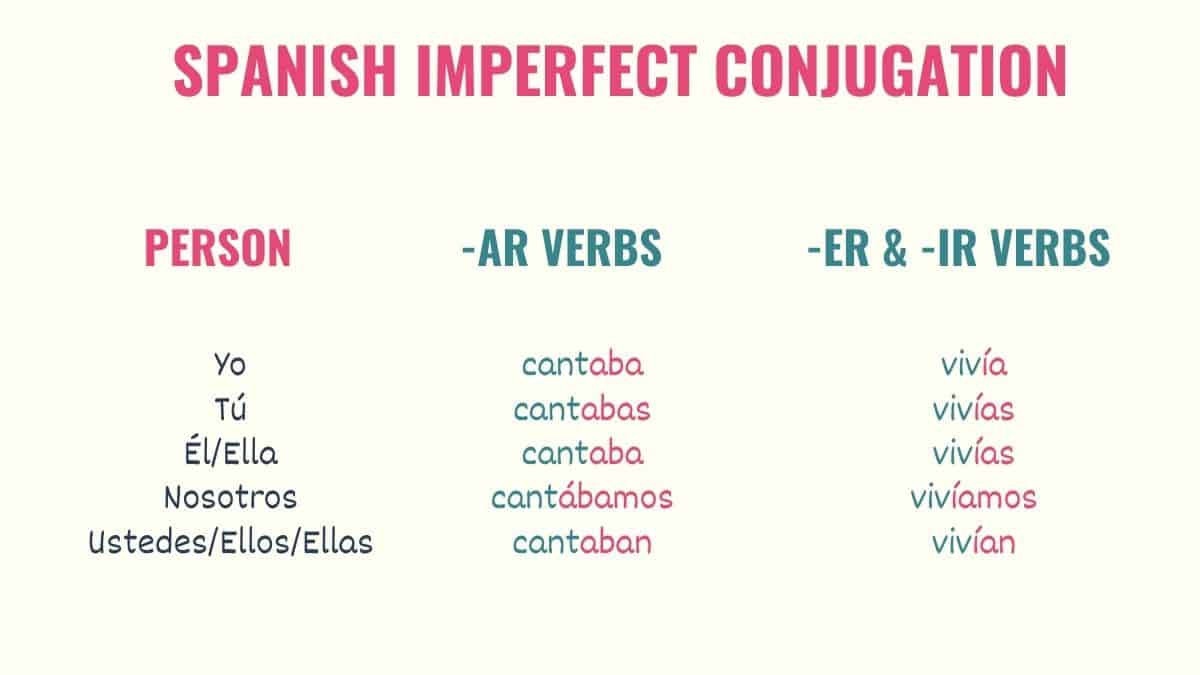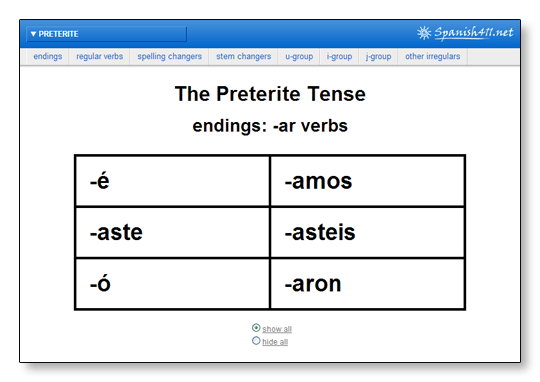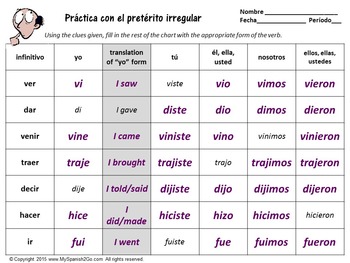

A verb which does not follow these patterns exactly is called an irregular verb.


There are only two sets of endings for regular preterite verbs one for -ar.
DECIR PRETERITE ENDINGS FOR FREE
Learn this and more for free with Live Lingua.
DECIR PRETERITE ENDINGS HOW TO
Irregular VerbsĪ verb is called a regular verb when its conjugation follows a typical pattern. For the preterite tense conjugation go to Decir Preterite Tense Conjugation. A clean and easy to read chart to help you learn how to conjugate the Spanish verb decir in Preterite Perfect Subjunctive tense. The imperfect tense is rarely irregular and can be easily conjugated from this form, which is the yo, and él/ella conjugation. The present perfect tense is formed by combining the auxiliary verb haber with the participio. Haber appears on the 100 Most Used Spanish Preterite Tense Verbs Poster as the 3rd most used irregular verb.įor the present tense conjugation, go to Haber Conjugation - Present Tense. Haber is conjugated as an irregular verb in the preterite tense. (You said everything I wanted to hear.) The Spanish verb decir has multiple conjugations that are used depending on the context. ¿Quién las lámparas de la oficina? (componer)Haber is a Spanish verb meaning to have. Gabriel García Marquéz un escritor colombiano muy famoso. Tú dos párrafos del texto para entender mejor. ¿Ustedes a sus padres sobre la reunión de hoy? (decir)ġ3. Ellos a la biblioteca después de su entrenamiento. The verb decir also has a stem change, which means that the e in the stem. Nosotros en la casa de Pedro desde el viernes pasado. To conjugate regular -ar verbs in the preterite, simply drop the ending (-ar).

Sara ensalada de frutas para los estudiantes esta mañana. ¿Qué tú el fin de semana pasado? (hacer)ĩ. Niños ¿dónde ustedes los juguetes que compramos ayer? (poner)Ĩ. Luis y su novia ir al concierto el sábado. ¿Qué tú que comprar para tu viaje a Sudamérica? (tener)Ħ. ¿Tus padres a Australia el año pasado? (ir)ĥ. Yo 100 dólares por mis botas de invierno. The preterite tense endings are: e, iste, o, imos, isteis, ieron. It is a u-stem verb, the stem changes from o to u. Yo la dirección del restaurante en Google Maps. The verb poder (to be able) is irregular in the preterite tense.
DECIR PRETERITE ENDINGS TRIAL
Prices as low as just $11 per hour for your first purchase of lessons!ĬLICK FOR YOUR FREE TRIAL CLASS! Interactive Grammar ExerciseĬomplete the following sentences with the Preterite of the irregular verbs given in brackets.ġ. Exercises for preterite stem-changing verbs (pdf)Ĭlick below to register for a free class with no obligation - no credit card needed.Decir Conjugation in Spanish, Translation, and Examples>Decir. Exercises for preterite irregular verbs (pdf) Preterite (Past Tense) Conjugation Chart Pretrito (pretrito perfecto simple) Uses of.Exercises for preterite regular verbs (pdf).Notes on other stem changing verbs with the preterite.Notes on orthographic changes with the preterite.Notes on preterite with irregular verbs.Notes & Exercises on the Spanish Preterite Other irregular verbs that follow a different pattern are: SER, IR, DAR and HABER Note: The verbs whose stem in the preterite end in “j” (e.g.: Conducir = Conduj) add the ending “eron” instead of “ieron” in the 3 rd person plural. To form the irregular verb, add the endings above to the preterite stems. Here you have a list of irregular verbs and their stems in the preterite. Here you have some examples and a list of irregular verbs with their corresponding stems: These endings are different to the ones that regular preterite verbs in Spanish share. They change the stem of the verb into a different stem, and then all of them add the same set of endings. Many of the irregular Spanish verbs in the preterite follow the same pattern. Note: The verbs whose stem in the preterite end in j (e.g.: Conducir Conduj) add the ending eron instead of ieron in the 3 rd person plural. Irregular Verbs in the Preterite - Verbos Irregulares Here you have a list of irregular verbs and their stems in the preterite. The changes in these verbs do not always follow a clear pattern and so you will need to memorize many of them. Then we have the preterite irregular verbs. Other verbs with a similar pattern are traer and conducir. Regular verbs have three different endings in the infinitive form, so by applying this rule you can conjugate them all. In the preterite tense conjugations, the irregular endings of decir include the letter j, as in dije (I said). We previously looked at regular verbs in the preterite. In order to form the preterite we need to remember certain rules. We use the preterite to talk about past events and facts that happened at a specific point in the time.


 0 kommentar(er)
0 kommentar(er)
